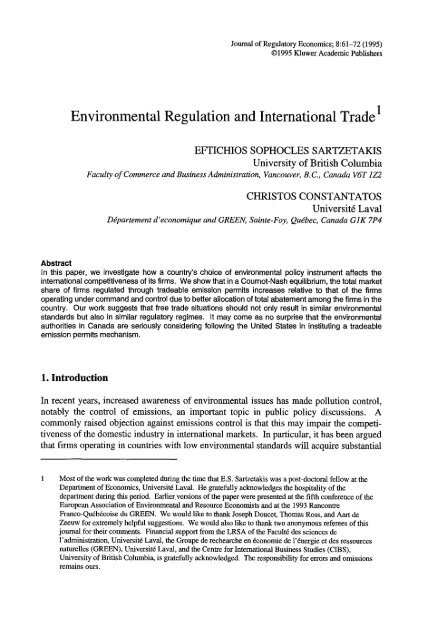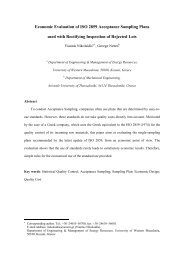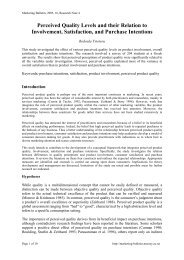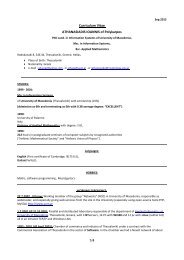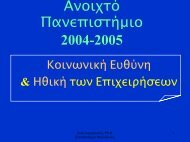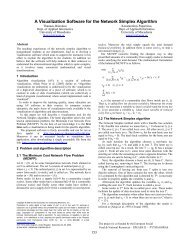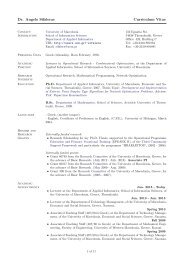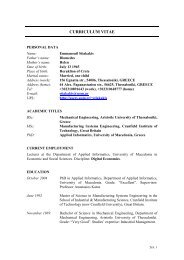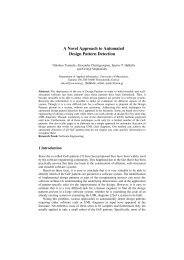Environmental regulation and international trade - Springer
Environmental regulation and international trade - Springer
Environmental regulation and international trade - Springer
You also want an ePaper? Increase the reach of your titles
YUMPU automatically turns print PDFs into web optimized ePapers that Google loves.
Journal of Regulatory Economics; 8:61-72 (1995)<br />
9 Kluwer Academic Publishers<br />
<strong>Environmental</strong> Regulation <strong>and</strong> International Tradel<br />
EFTICHIOS SOPHOCLES SARTZETAKIS<br />
University of British Columbia<br />
Faculty of Commerce <strong>and</strong> Business Administration, Vancouver, B.C., Canada V6T 1Z2<br />
CHRISTOS CONSTANTATOS<br />
Universit6 Laval<br />
Ddpartement d' economique <strong>and</strong> GREEN, Sainte-Foy, Qudbec, Canada GIK 7P4<br />
Abstract<br />
In this paper, we investigate how a country's choice of environmental policy instrument affects the<br />
<strong>international</strong> competitiveness of its firms. We show that in a Cournot-Nash equilibrium, the total market<br />
share of firms regulated through <strong>trade</strong>able emission permits increases relative to that of the firms<br />
operating under comm<strong>and</strong> <strong>and</strong> control due to better allocation of total abatement among the firms in the<br />
country. Our work suggests that free <strong>trade</strong> situations should not only result in similar environmental<br />
st<strong>and</strong>ards but also in similar regulatory regimes. It may come as no surprise that the environmental<br />
authorities in Canada are seriously considering following the United States in instituting a <strong>trade</strong>able<br />
emission permits mechanism.<br />
1. Introduction<br />
In recent years, increased awareness of environmental issues has made pollution control,<br />
notably the control of emissions, an important topic in public policy discussions. A<br />
commonly raised objection against emissions control is that this may impair the competitiveness<br />
of the domestic industry in <strong>international</strong> markets. In particular, it has been argued<br />
that firms operating in countries with low environmental st<strong>and</strong>ards will acquire substantial<br />
Most of the work was completed during the time that E.S. Sartzetakis was a post-doctoral fellow at the<br />
Department of Economics, Universit6 Laval. He gratefully acknowledges the hospitality of the<br />
department during this period. Earlier.versions of the paper were presented at the fifth conference of the<br />
European Association of <strong>Environmental</strong> <strong>and</strong> Resource Economists <strong>and</strong> at the 1993 Rancontre<br />
Franco-Qu6b6coise du GREEN. We would like to thank Joseph Doucet, Thomas Ross, <strong>and</strong> Aart de<br />
Zeeuw for extremely helpful suggestions. We would also like to thank two anonymous referees of this<br />
journal for their comments. Financial support from the LRSA of the Facult6 des sciences de<br />
l'administration, Universit6 Laval, the Groupe de rechearche en 6conomie de l'6nergie et des ressources<br />
naturelles (GREEN), Universit6 Laval, <strong>and</strong> the Centre for International Business Studies (CIBS),<br />
University of British Columbia, is gratefully acknowledged. The responsibility for errors <strong>and</strong> omissions<br />
remains ours.
62 EFTICHIOS SOPHOCLES SARTZETAKIS AND CHRISTOS CONSTANTATOS<br />
cost advantages over <strong>international</strong> competitors operating in more environmentally conscious<br />
countries. Concern has even been expressed that some countries could become "pollution<br />
havens" by attracting industries through low environmental st<strong>and</strong>ards; see for example,<br />
Markusen et al. (1993). While earlier empirical research by Leonard (1988) <strong>and</strong> Tobey<br />
(1989; 1990) suggested that differences in environmental st<strong>and</strong>ards did not have significant<br />
impact on <strong>trade</strong> patterns, more recent work by Lucas et al. (1992) showed that this impact<br />
may be important.<br />
Substantial literature has been devoted to the impact of environmental policy on <strong>trade</strong><br />
patterns. 2 The link between <strong>trade</strong> <strong>and</strong> the environment is rooted in policy rigidities that<br />
prevent authorities from achieving first best optimality. In the absence of any restrictions<br />
on the use of environmental <strong>and</strong> <strong>trade</strong> policies, any impact the former might have on a<br />
country's terms of <strong>trade</strong> could easily be offset by the appropriate choice of tariffs. International<br />
agreements as well as the action of domestic lobbying groups may in fact limit the<br />
applicability of <strong>trade</strong> <strong>and</strong>/or environmental policy instruments. Baumol <strong>and</strong> Oates (1988)<br />
<strong>and</strong> Markusen (1975) consider limitations in the exercise of environmental policy <strong>and</strong><br />
examine modifications to the first-best tariffs necessary to account for environmental issues.<br />
Krutilla (1991) <strong>and</strong> Markusen (1975) consider cases in which <strong>international</strong> <strong>trade</strong> agreements<br />
limit the use of tariffs leaving environmental <strong>regulation</strong> as the only feasible policy towards<br />
rent extraction from foreigners. In all cases, it is found that the second-best tariff or<br />
environmental tax may be higher or smaller compared to its first-best level.<br />
Kennedy (1994) also considers environmental policy as the only instrument in the<br />
presence of transboundary pollution within an imperfectly competitive global environment.<br />
Rather than looking at the optimal tax level, he determines the Nash equilibrium pollution<br />
taxes <strong>and</strong> shows that strategic interaction between countries results to equilibrium taxes that<br />
are lower than what is globally efficient. Finally, Copel<strong>and</strong> (1994) recognizes the possibility<br />
of restrictions on the use of both environmental <strong>and</strong> <strong>trade</strong> policy instruments <strong>and</strong> investigates<br />
conditions for gradual policy reforms to be welfare improving. His work emphasizes the<br />
need for coordinated <strong>trade</strong> <strong>and</strong> pollution policies in order to avoid exacerbating distortions<br />
<strong>and</strong> shows that small policy reforms may be more easily implemented under a quota rather<br />
than a tax regime. He also finds that <strong>international</strong> factor mobility increases the benefits from<br />
reforming pollution policy.<br />
In this paper, we deal with the impact of environmental policy on <strong>trade</strong> patterns. Our<br />
work differs from the aforementioned papers in that, instead of focusing on the level of<br />
environmental st<strong>and</strong>ards, we concentrate on the impact of the type of regulatory regime on<br />
a country's <strong>international</strong> competitiveness. This particular focus is motivated by the following<br />
observations. First, the fact that some countries have already adopted "incentive based"<br />
regulatory policy instruments--namely taxes <strong>and</strong> <strong>trade</strong>able emissions permits--while others<br />
are more hesitant to move in this direction <strong>and</strong> continue to apply comm<strong>and</strong> <strong>and</strong> control<br />
regimes. Second, that environmental st<strong>and</strong>ards tend not to be significantly different among<br />
developed countries; see Cropper <strong>and</strong> Oates (1992). The similarity of st<strong>and</strong>ards is merely<br />
2 See, for instance, Markusen (1975a); Pething (1976); McGuire (1982); Merrifield (1988); Baumol <strong>and</strong><br />
Oates (1988); Krutilla (1991); Copel<strong>and</strong> <strong>and</strong> Taylor (1992); Copel<strong>and</strong> (1994); <strong>and</strong> Kennedy (1994).
ENVIRONMENTAL REGULATION AND INTERNATIONAL TRADE 63<br />
due to similar preferences for environmental protection <strong>and</strong>/or <strong>international</strong> agreements.<br />
Concerning the latter, one can argue that as rising environmental consciousness pushes<br />
countries towards more stringent <strong>regulation</strong>, free-<strong>trade</strong> agreements will no longer be able to<br />
neglect environmental issues; the need to prevent the use of lax environmental st<strong>and</strong>ards as<br />
a substitute for <strong>trade</strong> policy will make <strong>international</strong> agreements a necessary complement to<br />
any tariff-reducing agreement. Thus, a certain convergence of pollution st<strong>and</strong>ards among<br />
countries may arise as a side effect of the current trend towards <strong>trade</strong> liberalization. 3 There<br />
is, however, no apparent reason why <strong>international</strong> agreements should impose on participant<br />
countries any specific regulatory regime.<br />
Even in a context of differing environmental st<strong>and</strong>ards, the impact of differing regimes<br />
on <strong>international</strong> competitiveness should not be neglected. As we show, for large differences<br />
in abatement technology, a more efficient regulatory regime may yield an advantage<br />
substantial enough to outweigh any <strong>trade</strong> disadvantage stemming from a more stringent<br />
environmental <strong>regulation</strong>. Thus, the country with the more efficient regulatory regime can<br />
either increase its <strong>international</strong> market share or afford a better environmental protection<br />
without putting its firms in a competitive disadvantage.<br />
Among the various regulatory instruments, Pigouvian taxes, <strong>trade</strong>able emission permits<br />
(TEP), <strong>and</strong> comm<strong>and</strong> <strong>and</strong> control (CAC) are the most commonly used. The equivalence of<br />
emission taxes <strong>and</strong> permits, when there are no transaction costs or imperfections in the permit<br />
market <strong>and</strong> the regulator has full information, is well established in the literature. While<br />
Pigouvian taxes are used mainly in Europe, there is an increasing interest in North America<br />
in the use of <strong>trade</strong>able permits as an alternative to the widespread CAC <strong>regulation</strong>. In the<br />
present paper, we employ emission permits as the representative of the incentive based<br />
instruments. A number of studies have tried to evaluate the welfare merits of each system<br />
by performing comparative statics in a closed economy; see, for example, Malueg (1990),<br />
Copel<strong>and</strong> (1990), <strong>and</strong> Sartzetakis (1993). However, no work has yet examined the simultaneous<br />
use of different types of <strong>regulation</strong> in an <strong>international</strong> <strong>trade</strong> context.<br />
In this paper, we consider two countries imposing the same environmental st<strong>and</strong>ards<br />
through different regulatory regimes <strong>and</strong> examine the potential effects of this asymmetry on<br />
<strong>trade</strong> patterns. More specifically, we are interested in finding whether the adoption of any<br />
specific regime might help a country's industry to increase its share in <strong>international</strong> markets.<br />
The paper is organized as follows: section 2 describes the main model in the absence of<br />
<strong>regulation</strong>; sections 3 <strong>and</strong> 4 derive the reaction functions of the firms under a CAC <strong>and</strong> a<br />
TEP <strong>regulation</strong>, respectively; <strong>and</strong> section 5 analyses the free-<strong>trade</strong> equilibrium under the<br />
simultaneous presence of both regulatory regimes. Section 6 contains the concluding<br />
remarks. Most proofs have been abbreviated with more details provided in the corresponding<br />
appendices.<br />
This prediction should be moderated by the presence of issues related to transboundary pollutants,<br />
differences in income distribution, <strong>and</strong> strategic considerations; see Markusen (1975b); Hoel (1991; <strong>and</strong><br />
1992); van der Ploeg <strong>and</strong> de Zeeuw (1992); Xepapadeas (1994); <strong>and</strong> Kennedy (1994).
64 EFTICHIOS SOPHOCLES SARTZETAKIS AND CHRISTOS CONSTANTATOS<br />
2. The Model<br />
We assume two countries, North, N, <strong>and</strong> South, S, producing a differentiated product which<br />
is sold in an <strong>international</strong> market. Each variety of the product is produced exclusively in<br />
= _b v ~ u<br />
each country, <strong>and</strong> its inverse dem<strong>and</strong> is pV a Q - Q , with b > ~ > 0 <strong>and</strong> v,u = N,S.<br />
On the supply side, we assume that each country' s output is produced by two firms, acting<br />
as Cournot oligopolists. 4 For analytical simplicity, marginal production cost, c, is assumed<br />
constant <strong>and</strong> equal across firms. Firm i in country v, i = 1,2 <strong>and</strong> v = N,S, chooses qV to<br />
maximize (pV _ c)qV, taking as given qy <strong>and</strong> QU, the total output in the other country. Firm<br />
i,v's reaction function is qV= [(a- c)/2b] - [q]/2] - [SQU/2b].<br />
Solving the system of<br />
A<br />
reaction functions, we obtain each firm's output level, qV = (a - c)/(3b + 25). The aggregate<br />
level of output in each country is<br />
^ 2 -<br />
Qv = ~ . (1)<br />
Production of the differentiated good is assumed to result in emissions of a common<br />
pollutant. It is further assumed that the discharge of the pollutant is proportional to the firm's<br />
^ A<br />
level of output, E v = rq v, which implies that each country's level of emissions is E v = rQ v.<br />
We assume that the governments in the two countries decide to reduce pollution by imposing<br />
similar ceilings in emissions. Reducing emissions is costly in that it requires either a<br />
reduction in output <strong>and</strong>/or the undertaking of some costly abatement. Total abatement,<br />
A v<br />
= o~i<br />
v<br />
qi,<br />
v<br />
is a function of a firm's level of output as well as of its chosen level of abatement<br />
per unit of output ~v. Total abatement cost is assumed to be quadratic in abatement,<br />
C v v v , v v,2<br />
= dt~i qi + eil.t~i qi) , i = 1,2, v = N,S, where d, e i > 0 represent technological parameters.5<br />
Abatement technologies differ among firms within the same country, but they are identical<br />
across countries, e N = e S = ei, i = 1,2. 6 Also, e 1 > e2, such that firms characterized by e i may<br />
be thought of as having less modern abatement technology. The similarity in the abatement<br />
cost profiles of the two countries rules out any changes in market shares originating in<br />
technological advantages of one of the counlxies, thus, allowing us to concentrate on changes<br />
strictly attributable to the difference in the regulatory regimes.<br />
While an equally stringent <strong>regulation</strong> is assumed in both countries, 7 the regulatory regime<br />
through which environmental protection is sought is different: country N imposes a CAC<br />
4 The model generalizes for n number of firms as long as at least two distinct abatement technologies<br />
remain in use. The model also generalizes in the case of free entry, as long as there is restricted entry in<br />
the use of the more efficient technology.<br />
5 The assumption of quadratic abatement costs yields downward sloping dem<strong>and</strong> curves for emission<br />
permits, in the case that a <strong>trade</strong>able emission permits <strong>regulation</strong> is chosen.<br />
6 The main result of the paper holds even if we allow dl > d2. However, expositional complexity increases<br />
substantially with differences in d term.<br />
7 We assume that the <strong>regulation</strong> is not as stringent as to induce the exit of some firms under any regulatory<br />
regime, i.e., qlv > 0, i = 1,2, v = N,S.
ENVIRONMENTAL REGULATION AND INTERNATIONAL TRADE 65<br />
<strong>regulation</strong>, while in country S a TEP system is implemented. The assumptions of similar<br />
st<strong>and</strong>ards <strong>and</strong> similar technology profiles isolate the effects of the regulatory mechanisms<br />
<strong>and</strong> avoid results that are due to other factors.<br />
3. North (Comm<strong>and</strong> <strong>and</strong> Control)<br />
In the present paper, we specify the CAC <strong>regulation</strong> as requiring all polluters to reduce their<br />
emissions by the same amount, E~/- ~/, with L-/r 2~/, i= 1,2, the aggregate emissions<br />
ceiling in country N. In order to avoid unnecessary repetitions, hereafter, ij = 1,2 <strong>and</strong> i r<br />
Each firm in country N chooses output <strong>and</strong> abatement per unit of output by maximizing<br />
profits subject to the emissions constraint, ~v/= E~/- A N. Firm i's Lagrange maximization<br />
problem is<br />
.NN r NNV N<br />
max L N = (a - bQ N- 5Q S) qN_ cqN_ clo~ i qi - e i~O~i qi ) + It'i~--~ - rqi + ~ J"<br />
N<br />
Setting ~LN/~o~ N = 0, we obtain 8 Li = d + 2eiaNq N, which implies that each firm reduces<br />
output to the point at which the marginal loss in profit from foregone output is equal to the<br />
marginal cost of abatement. 9 Firm i's output as a function of the Lagrange multipliers <strong>and</strong><br />
country S's output is<br />
qN = a - c - r(29~ i - )~j) 5 a S.<br />
3b - -377 (3)<br />
Aggregating over i, we obtain North's total output as a function of South's total output,<br />
QN = 2(a - c) - r(~, 1 + ~'2) 25 a S.<br />
30 - 3-6 (4)<br />
As shown in Appendix 1, if e 1 > e 2 then ~1 > )~2, which by simple inspection of equation<br />
N N 9 v v --<br />
(3) implies ql < q2. This, together with the regulatory constraint Ai = rqi - EN/2, implies<br />
A N < A N. Thus, within country N, the firm with the higher marginal abatement cost engages<br />
in a relatively lower level of abatement, <strong>and</strong> its market share is reduced relative to the other<br />
firm.<br />
4. South (Tradeable Emissions Permits)<br />
Country S implements a TEP <strong>regulation</strong> by which polluting sources are required to obtain<br />
emission permits for the quantity of pollutant they wish to emit. Each permit specifies an<br />
amount of allowable emissions, assumed to be one unit, <strong>and</strong> is freely transferable. The<br />
8 See Appendix 1 for details on the maximization of (2).<br />
9 We assume that the value of d relative to dem<strong>and</strong> parameters is not so high as to induce farms to engage in<br />
no abatement under any regulatory regime.
66 EFTICHIOS SOPHOCLES SARTZETAKIS AND CHRISTOS CONSTANTATOS<br />
assumption of identical environmental st<strong>and</strong>ards between countries requires that the number<br />
of permits issued by the regulator in country S is equal to the maximum allowable units of<br />
emission in country N, i.e., ~v = ~.s. The regulator distributes the permits free of charge to<br />
the firms, with firm i receiving E~/= Es/2 permits. After the initial distribution of permits,<br />
firms can freely <strong>trade</strong> permits.<br />
With the introduction of <strong>trade</strong>able permits, another market is added to the model. This<br />
market can either be perfectly or imperfectly competitive. We assume here that the pollutant<br />
in question is emitted by many industries producing goods with zero cross-price elasticity<br />
of dem<strong>and</strong> <strong>and</strong> that the distribution of high <strong>and</strong> low abatement cost firms is similar across<br />
industries. Thus, while firms are Cournot players in the product market, they are price takers<br />
in the emission permits market. Firm i's net dem<strong>and</strong> for permits is NE~/= E//- ES/2, where<br />
E~/= E~/- A s is firm i's dem<strong>and</strong> for permits; in equilibrium, ]E2=1NE~i=O.<br />
Firm i's profit maximization problem is<br />
max n S = (a - bQS-SQN) qSi-s- cqi - a~ ss qi - ei (~SqS~ - P ~ (r - c~ S) qS _~__2_1<br />
s s<br />
i<br />
qi ,~i (5)<br />
where P~ is the price of permits. Setting ~/S/~o~S = 0 implies 10 pE = d + 2eio~Sq S, so that<br />
each firm sells or buys permits until its marginal cost of an extra permit is equal to its marginal<br />
cost of abatement. Firm i's output as a function of the permit price <strong>and</strong> North' s output is<br />
qS= a - c - rP e 8<br />
3b - 3-~ QN. (6)<br />
Aggregating output over i, we obtain total output in South as a function of North's output,<br />
Qs 2(a-c-rP E) 28<br />
= 3b - 3-6 QN. (7)<br />
From (A. 14), it is clear that el > e2 implies A s < A s. Therefore, the lower abatement cost<br />
firm engages in a relatively higher level of abatement <strong>and</strong> sells its excess permits to the high<br />
abatement cost firm. Since at the equilibrium the marginal abatement cost of both firms<br />
equals pC, the introduction of environmental <strong>regulation</strong> leaves relative market shares of the<br />
firms in country S unchanged, so that ~/QS=qS/QS.<br />
5. Trade Equilibrium with Regulation<br />
Solving simultaneously equations (4) <strong>and</strong> (7), we obtain QN, Qs as functions of the<br />
equilibrium values of L1, ~2, <strong>and</strong> pE,<br />
10 See Appendix 2 for details on the maximization of (5).
ENVIRONMENTAL REGULATION AND INTERNATIONAL TRADE 67<br />
QN = 2(3b - 28) (a - c) - 3rb(~, 1 + ~'2) + 4rSPE<br />
(3b - 2~5) (3b + i5)<br />
(8)<br />
<strong>and</strong><br />
Qs = 2(3b - 25) (a - c) + 2r5(~, 1 + L2) - 6rbP ~<br />
(3b - 25) (3b + i5) (9)<br />
From the above expressions, we can see that QN+QS-2Q=r(45-6b)[Pe<br />
+ (~,1 + ~,2)/2] < 0, since b > 5. Thus, total output decreases after the introduction of<br />
environmental <strong>regulation</strong>. This should not come as a surprise, as the <strong>regulation</strong> imposes an<br />
additional cost upon the firms. What is crucial in our analysis is to determine how the burden<br />
of output reduction is distributed among countries. To that end, we need first to establish a<br />
relation between the equilibrium price of permits <strong>and</strong> the values of the Lagrange multipliers.<br />
Under the assumption that both countries set the same emissions ceiling, ~r = ~7 S, we have<br />
rQ N - A N = rQ S - A S, where A v = Z2=1 A v, v = N,S. Substituting into this condition the<br />
values of QN, Qs, A N <strong>and</strong> A S from (8), (9), (A.5), <strong>and</strong> (A.14), respectively, we derive the<br />
following relationship between the competitive permit price <strong>and</strong> the Lagrange multipliers:<br />
pE = (3b - 25) (3b + 2fi) (el~, 2 -I- e2~,l) + 2ele2r2(3b + 45) (~1 + ~'2) (10)<br />
4ele2r2(3b + 45) + (3b - 25) (3b + 28) (e 1 + e2)<br />
Setting the RHS of (10) smaller than the average of L's <strong>and</strong> cross-multiplying, we obtain<br />
(3b - 25) (3b + 25) (el - e2) (L2 - ~,1) < 0. Since b > 5, a necessary <strong>and</strong> sufficient condition<br />
for pe < (L1 + ~,2)/2 is that (el - e2) (~,2 - ~,1) < 0. The LHS of this expression can never be<br />
positive, since el > e2 implies ~,I > ~,2; it cannot be zero either, unless both firms in the N<br />
country possess the same abatement technology. Thus, in the free-<strong>trade</strong> regulated equilibrium,<br />
if el ~e e2 then the price of emission permits in country S is lower than the average of<br />
the Lagrange multipliers in country N, i.e., e 1 #: e 2 pE < (~1 + ~2)/2.<br />
This result reflects the advantage of a TEP <strong>regulation</strong> in distributing abatement effort more<br />
efficiently between firms. Indeed, since pe > ~,2 (see Appendix 2 for the proof), it follows<br />
from (A.5) <strong>and</strong> (A.14) that As = (pC _ d)/2e2 > (~,2 - d)/2e2 =A N. Thus, in South the low<br />
abatement cost firm undertakes a greater amount of abatement activity than its counterpart<br />
in country N. By encouraging higher abatement by the low cost firm, a TEP <strong>regulation</strong> results<br />
in a more efficient allocation of abatement effort. This advantage vanishes when technologies<br />
are similar <strong>and</strong> its importance is directly related to the technological heterogeneity within<br />
the country that implements a CAC <strong>regulation</strong>.<br />
Turning to the question of changes in market shares after the introduction of <strong>regulation</strong>,<br />
recall first that all firms produce similar outputs in the pre-<strong>regulation</strong> equilibrium. Taking<br />
the difference between (8) <strong>and</strong> (9) <strong>and</strong> rearranging terms, we can show that the difference<br />
Qs_ QN is proportional to the expression r(25+ 3b) (~1 +L2- 2PE) > 0, since<br />
el r e2 Pe < (~,1 + ~2)/2.<br />
Thus, in the presence of diverse abatement technologies
68 EFTICHIOS SOPHOCLES SARTZETAKIS AND CHRISTOS CONSTANTATOS<br />
within each country, the aggregate market share of the firms regulated through a TEP system<br />
increases relative to its pre-<strong>regulation</strong> level while that of the firms operating under a CAC<br />
system is reduced. Therefore, for the environmental <strong>regulation</strong> not to have any effect on the<br />
<strong>trade</strong> pattern between two regions, not only similar st<strong>and</strong>ards, but also similar regulatory<br />
mechanism must be adopted.<br />
The advantage of country S's industry in this model is due to the fact that while a TEP<br />
system results in the efficient allocation of abatement effort between firms with differing<br />
technologies, a CAC <strong>regulation</strong> fails to do so. This advantage increases with the diversity<br />
in abatement technologies <strong>and</strong> can become so significant as to outweigh the impact of<br />
<strong>regulation</strong> <strong>and</strong> result in an increase in country S's output in absolute terms. Comparison of<br />
(1) <strong>and</strong> (9) reveals that for this to be true the second term in (9) must be positive, i.e.,<br />
2~r(~,i + ~j) - 6brP e > 0, which holds when pe < (2~5/3b) (~,i + ~,j)/2. The latter is more<br />
likely when ~5 is close to b, so the two countries' products are close substitutes <strong>and</strong> the<br />
equilibrium price of permits is very low compared to the average of the Lagrange multipliers.<br />
6. Conclusions<br />
We investigate how a country's choice of environmental policy instrument affects the<br />
<strong>international</strong> competitiveness of firms in that country. We show that in a Cournot-Nash<br />
equilibrium, the total market share of firms regulated through a TEP system increases relative<br />
to that of the firms operating under a CAC system. This is due to the fact that a TEP system<br />
better allocates total abatement among the firms in the country. The advantage of a TEP<br />
system becomes more pronounced as the diversity of abatement technologies within the<br />
country that implements a CAC <strong>regulation</strong> is increased. For large differences between the<br />
two firms' abatement costs, the enactment of environmental <strong>regulation</strong> may increase the<br />
output of the country that implements a TEP <strong>regulation</strong> relative to the pre-<strong>regulation</strong><br />
situation. Our work suggests, therefore, that free <strong>trade</strong> situations should not only result in<br />
similar environmental st<strong>and</strong>ards but also in similar regulatory regimes. The fact that<br />
environmental authorities in Canada are seriously considering following the United States<br />
in instituting environmental <strong>regulation</strong>s through <strong>trade</strong>able emission permits systems is<br />
consistent with the above result.<br />
The advantage of TEP <strong>regulation</strong>s must be qualified for the competitive emission permit<br />
market assumption. Hanh (1984) has shown that in autarky, when the industry is competitive,<br />
a non-competitive permit market result in efficiency losses, but remains more efficient<br />
than a CAC system. Further, Sartzetakis (1993) fias shown that a CAC <strong>regulation</strong> may be<br />
welfare superior to a non-competitive permits market when the industry is also non-competitive.<br />
These results indicate that the advantage of a TEP system may be substantially<br />
reduced in the presence of imperfections in the permits market.<br />
References<br />
Baumol, W.J., <strong>and</strong> W.E. Oates. 1988. The Theory of <strong>Environmental</strong> Policy. Cambridge U.K.:<br />
Cambridge University Press.<br />
Copel<strong>and</strong>, B.R. 1990. "Taxes Versus St<strong>and</strong>ards to Control Pollution in Imperfectly Competitive<br />
Markets." Mimeo: University of British Columbia. /
ENVIRONMENTAL REGULATION AND INTERNATIONAL TRADE 69<br />
Copel<strong>and</strong>, B.R. 1994. "International Trade <strong>and</strong> the Environment: Policy Reform in a Polluted Small<br />
Open Economy." Journal of <strong>Environmental</strong> Economics <strong>and</strong> Management 26: 44-65.<br />
Copel<strong>and</strong>, B.R., <strong>and</strong> S. Taylor. 1992. "North-South Trade <strong>and</strong> the Environment." Mimeo: University<br />
of British Columbia.<br />
Cropper, M. L., <strong>and</strong> W. Oates. 1992. "<strong>Environmental</strong> Economics: A Survey." Journal of Economic<br />
Literature XXX: 675-740.<br />
Hahn, R.W. 1984." Market Power <strong>and</strong> Transferable Property Rights." Quarterly Journal of Economics<br />
99: 753-765.<br />
Hoel, M. 1991." Efficient International Agreements for Reducing Emissions of COa." Energy Journal<br />
12: 93-107.<br />
Hoel, M. 1992. "Carbon Taxes: An International Tax or Harmonized Domestic Taxes.'" European<br />
Economic Review 36: 400-407.<br />
Kennedy, P. 1994. "Equilibrium Pollution Taxes in Open Economies With Imperfect Competition."<br />
Journal of <strong>Environmental</strong> Economics <strong>and</strong> Management 27: 49-63.<br />
Krutilla, K. 1991. "<strong>Environmental</strong> Regulation in an Open Economy." Journal of <strong>Environmental</strong><br />
Economics <strong>and</strong> Management 21: 127-142.<br />
Leonard, H. J. 1988. Pollution <strong>and</strong> the Struggle for the Worm Product. Cambridge, U.K.: Cambridge<br />
University Press.<br />
Lucas, R.E.B., D. Wheeler, <strong>and</strong> H. Hettige. 1992. "Economic Development, <strong>Environmental</strong> Regulation,<br />
<strong>and</strong> the International Migration of Toxic Industrial Pollution 1960-88." World Development<br />
Report. WPS 1062: The World Bank.<br />
Malueg, D.A. 1990. "Welfare Consequences of Emission Credit Trading Programs." Journal of<br />
<strong>Environmental</strong> Economics <strong>and</strong> Management 19: 66-77.<br />
Markusen, J.R. 1975a. "International Externalities <strong>and</strong> Optimal Tax Structures." Journal oflnternational<br />
Economics 5:15-29.<br />
Markusen, J.R. 1975b. "Cooperative Control of International Pollution <strong>and</strong> Common Property<br />
Resources." Quarterly Journal of Economics 89:618-632.<br />
Markusen, J.R., E.R. Morey, <strong>and</strong> N.D. Olewiler. 1993." <strong>Environmental</strong> Policy When Market Structure<br />
<strong>and</strong> Plant Locations are Endogenous." Journal of <strong>Environmental</strong> Economics <strong>and</strong> Management 24:<br />
69-87.<br />
McGuire, M. 1991. "Regulation, Factor Rewards <strong>and</strong> International Trade." Journal of Public Economics<br />
12:93-107.<br />
Merrifield, J.D. 1988. "The Impact of Selected Abatement Strategies on Transnational Pollution, the<br />
Terms of Trade, <strong>and</strong> Factor Rewards: A General Equilibrium Approach." Journal of <strong>Environmental</strong><br />
Economics <strong>and</strong> Management 15: 259-284.<br />
Pethig, R. 1976. "Pollution, Welfare, <strong>and</strong> <strong>Environmental</strong> Policy in the Theory of Comparative<br />
Advantage." Journal of <strong>Environmental</strong> Economics <strong>and</strong> Management 2:160-169.<br />
Sartzetakis, E. S. 1993. Emission Permit Trading <strong>and</strong> Market Structure. Ph.D. Dissertation: Department<br />
of Economics, Carleton University, Ottawa.<br />
Tobey, J. A. 1989. The Impact of Domestic <strong>Environmental</strong> Policies on International Trade. Ph.D.<br />
Dissertation: Department of Economics, University of Maryl<strong>and</strong>.<br />
Tobey, J.A. 1990. "The Effects of Domestic <strong>Environmental</strong> Policies on Patterns of World Trade: An<br />
Empirical Test." Kyklos 43: 191-209.<br />
van der Ploeg, F., <strong>and</strong> A. de Zeeuw. 1992. "International Aspects of Pollution Control." <strong>Environmental</strong><br />
<strong>and</strong> Resource Economics 2:117-139.<br />
Xepapadeas, A. 1994. "Optimal Management of the International Commons: Resource Use <strong>and</strong><br />
Pollution Control." Fondazione Eni Enrico Mattei: working paper No 4.94.
70 EFTICHIOS SOPHOCLES SARTZETAKIS AND CHRISTOS CONSTANTATOS<br />
Appendix<br />
In this appendix, we provide some additional steps of the solution to the firms profit<br />
maximization problem both in country N <strong>and</strong> S.<br />
Appendix 1: North (comm<strong>and</strong> <strong>and</strong> control)<br />
Country N implements a comm<strong>and</strong> <strong>and</strong> control <strong>regulation</strong>. Firm i chooses qi <strong>and</strong> ~i,<br />
i = 1,2, by solving the following constrained profit maximization problem:<br />
max N LN = (a - bQN- SQS) qNi - d~ qi - ei(~i qi ) + ~'i<br />
qi '~<br />
The first-order conditions are:<br />
a- 2bqN-bqN-~QS-c-do~ N- 2ei(~i )2q N- ~i(r- ~N) = 0, (A.1)<br />
qbiTi(- d- 2ei~Niq N + ~'i) = 0,<br />
(A.2)<br />
NN<br />
~i qi = ---2-" (A.3)<br />
Using (A. 1) <strong>and</strong> (A.2), we obtain firm i's output reaction function as function of the Lagrange<br />
multiplier <strong>and</strong> country S's output,<br />
N a-c-r)~i 1 N<br />
qi = 2b - ~ qJ - ~2~ Qs. (A.4)<br />
Solving equations (A.4) for ij = 1,2 yields firms' output as shown in equation (3) in the main<br />
text.<br />
Firm i's level of abatement is,<br />
AN N N ~'i - d<br />
i = I~i qi = ---2-~i ' (A.5)<br />
which follows immediately from (A.2). Substitution of qN <strong>and</strong> A N from (3) <strong>and</strong> (A.5)<br />
respectively into (A.3) yields firm i' s Lagrange multiplier as a function of country S' s output,<br />
2eir(b + 2ejr 2) (a - c - 8Q S) - 6bei(b + 2ejr 2) ~<br />
+ b[3b + 2(2ej + el) r 2] d<br />
~i = 3b 2 + 4b(e i + ej) r 2 + 4eiejr 4 (A.6)<br />
The difference between the two firms' marginal costs of abatement in equilibrium is<br />
~1 - ~2 =<br />
2b(el - e2) [r(a - c - rd- 8QS) - 3bl~l - 2b(el - e2) r2d<br />
3b 2 + 4b(e 1 + e2) r 2 + ~e~e2 r4<br />
(A.7)<br />
Rearranging terms, equation (A.7) can be written as follows,
ENVIRONMENTAL REGULATION AND INTERNATIONAL TRADE 71<br />
3b2(el - e2) [ r2(a - c - rd-<br />
- EN]<br />
9~1 - )~a = 3b 2 + 4b(e 1 + e2 ) r e + 4ele2r4 (A.8)<br />
Excluding corner solutions, c~ N > 0, qN > 0, implies that )~i > d, from (A.5). This inequality,<br />
along with equation (4), implies,<br />
Equations (A.8) <strong>and</strong> (A.9) yield<br />
2(a-c-rd) 28QS<br />
3b - -3B > QN. (1.9)<br />
3b2(e1 - e2) (rQ N- E N)<br />
9~1 - L2 > 3b 2 + 4b(e 1 + e2 ) r 2 + 4ele2 4" (A.10)<br />
Aggregating the constraints of the two firms in country N, equation (A.3), we obtain:<br />
rQN _ A N = ~-dg.<br />
Since we exclude corner solutions for both output <strong>and</strong> abatement per unit of output, the<br />
aggregate emissions constraint implies rQ N > ~4v. The last inequality along with equation<br />
(1.10) implies L1 > )~2, since el > e2. It follows that (el - e2) ()~2 - )~1) < 0.<br />
Appendix 2: South (competitive <strong>trade</strong>able emissions permits market)<br />
Country S implements a <strong>trade</strong>able emission permit system. We assume that both firms<br />
are price takers;in~e Permit market. Firm i's optimal choice of qi <strong>and</strong> ~i, i = 1,2, is derived<br />
by solving the following profit maximization problem:<br />
max Jrc S = (a - bQ S - 8Q N) qS<br />
- cqi<br />
s<br />
- dtxi<br />
s<br />
qi<br />
s<br />
- ei(~<br />
s<br />
qi<br />
$2<br />
) - Pe[(r - ~i<br />
s<br />
)<br />
qS _ ~_~2_].<br />
S S<br />
qi ' O~i<br />
The first-order conditions are:<br />
a- 2bqS-bqy-SQN-c-do~ S- 2ei(o~S)2qS-pe(r-o~S)=o, (A.11)<br />
qSi(- d - 2eicxSq S + pE) = 0,<br />
(A.12)<br />
fr~om which we obtain firm i' s output reaction function<br />
qS=a-2;PPE 1 _ ~ qS_ ~/~ QN.<br />
(A.13)<br />
Solving the two reaction functions in (A.13) for ij = 1,2, we obtain (6).<br />
Equation (A. 12) yields the equilibrium abatement of firms in country S as function of the<br />
competitive permit price, P~,<br />
A S ~s s pe _ d<br />
i = iqi=--~i . (A.14)
72 EFTICHIOS SOPHOCLES SARTZETAKIS AND CHRISTOS CONSTANTATOS<br />
Finally, in order to prove that pe > ~,2, we replace pE by the RHS of (10). Simplifying<br />
<strong>and</strong> rearranging terms, we obtain that a necessary <strong>and</strong> sufficient condition for pe > L2 is<br />
(3b - 2~5) (3b + 25) e2(~, 1 - ~'2) + 2ele2 r2(3b + 4~5) (~1 - ~'2) > 0,<br />
which is true since ~,1 > ~,2 <strong>and</strong> b > 5.


